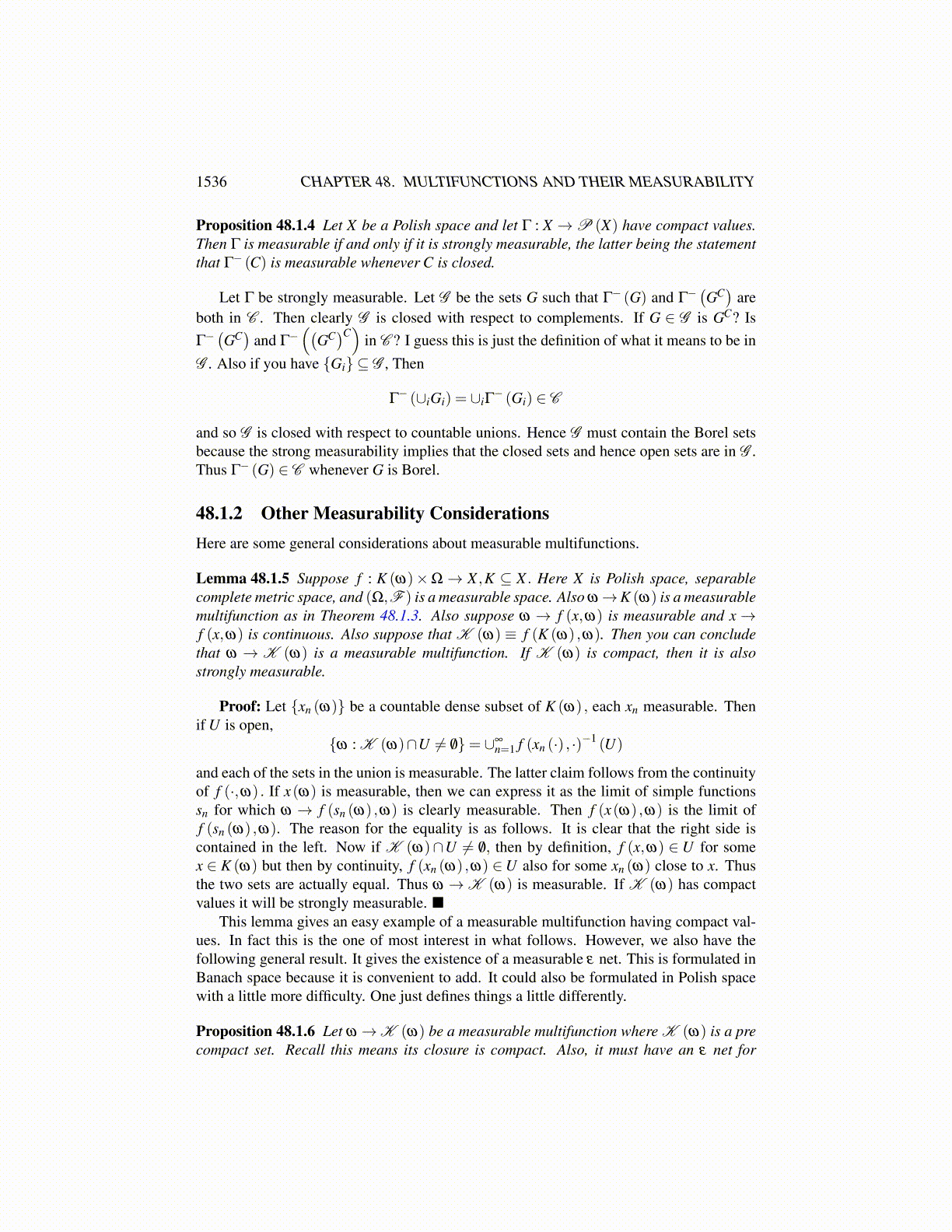
1536 CHAPTER 48. MULTIFUNCTIONS AND THEIR MEASURABILITY
1. For all U open in X ,Γ− (U) ∈ C
Γ− (U)≡ {ω : Γ(ω)∩U ̸= /0}
2. There exists a sequence, {σn} of measurable functions satisfying σn (ω) ∈ Γ(ω)such that for all ω ∈Ω,
Γ(ω) = {σn (ω) : n ∈ N}
These functions are called measurable selections.
Proof: First 1.) ⇒ 2.). A measurable selection will be obtained in Γ(ω). Let {xn}∞
n=1be a countable dense subset of X . For ω ∈Ω, let ψ1 (ω) = xn where n is the smallest integersuch that Γ(ω)∩B(xn,1) ̸= /0. Therefore, ψ1 (ω) has countably many values, xn1 ,xn2 , · · ·where n1 < n2 < · · · . Now
{ω : ψ1 = xn}=
{ω : Γ(ω)∩B(xn,1) ̸= /0}∩ [Ω\∪k<n {ω : Γ(ω)∩B(xk,1) ̸= /0}] ∈ C .
Thus we see that ψ1 is measurable and dist(ψ1 (ω) ,Γ(ω))< 1. Let
Ωn ≡ {ω ∈Ω : ψ1 (ω) = xn} .
Then Ωn ∈ C and Ωn∩Ωm = /0 for n ̸= m and ∪∞n=1Ωn = Ω. Let
Dn ≡ {xk : xk ∈ B(xn,1)} .
Now for each n, and ω ∈Ωn, let ψ2 (ω) = xk where k is the smallest index such that xk ∈Dnand B
(xk,
12
)∩Γ(ω) ̸= /0. Thus dist(ψ2 (ω) ,Γ(ω))< 1
2 and
d (ψ2 (ω) ,ψ1 (ω))< 1.
Continue this way obtaining ψk a measurable function such that
dist(ψk (ω) ,Γ(ω))<1
2k−1 , d(ψk (ω) ,ψk+1 (ω)
)<
12k−2 .
Then for each ω,{ψk (ω)} is a Cauchy sequence converging to a point, σ (ω) ∈ Γ(ω).
This has shown that if Γ is measurable, there exists a measurable selection, σ (ω) ∈ Γ(ω).Of course, if Γ(ω) is closed, then σ (ω) ∈ Γ(ω). Note that this had nothing to do with ameasure.
It remains to show there exists a sequence of these measurable selections σn such thatthe conclusion of 2.) holds. To do this we define
Γni (ω)≡{
Γ(ω)∩B(xn,2−i
)if Γ(ω)∩B
(xn,2−i
)̸= /0
Γ(ω) otherwise .
First we show that Γni is measurable. Let U be open. Then
{ω : Γni (ω)∩U ̸= /0}={
ω : Γ(ω)∩B(xn,2−i)∩U ̸= /0
}∪